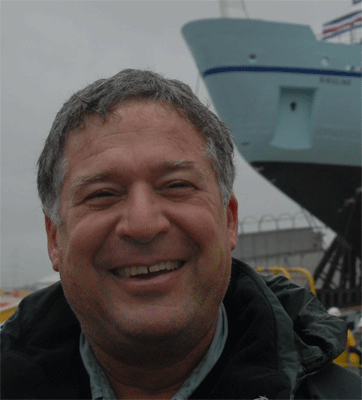Lee W. Cooper, Ph.D.
Coordinates:
Chesapeake Biological Lab, University of Maryland Center for Environmental Science, PO Box 38, 146 Williams St. Solomons, MD 20688, U.S.A.
Phone: +1.410.326.7359
email cooper@umces.edu
Education:
B.A. Biology, 1978, University of California, Santa Cruz
M.S. Botany, 1980, University of Washington
Ph.D. Oceanography, 1987, University of Alaska Fairbanks
Major Research Interests:
Stable and radioisotope composition of organic materials and natural waters; aquatic plant physiology; high latitude oceanography and hydrology
Links to Publications:
These networking links below provide information and access to my publications. In some cases, due to copyright restrictions, I cannot freely post my publications for download. For anything that is of interest that is not available, please send an email to cooper "at" umces.edu and I'll respond and provide .pdf files that I have available.
google.scholar.com: http://scholar.google.com/citations?user=zQJsba4AAAAJ&hl=en&oi=ao
Researchgate: http://www.researchgate.net/profile/Lee_Cooper2/
Publons: https://publons.com/researcher/1422239/l-w-cooper/
ORCID: http://orcid.org/0000-0001-7734-8388
SCOPUS: https://www.scopus.com/authid/detail.uri?authorId=7202473288
To access my publications using your mobile app, scan the QR code below:

A little bit about me: I
grew up in a southern California beach community, and was always
interested in the local marine environment. Marine plants, particularly
seagrasses were my first professional interest, and led to studies of
stable carbon isotopes, which vary in ways in seagrasses that are still
being explored. Some of the same seagrasses that grow on sunny beaches
in California also grow in Alaska, so to me it was completely
understandable to move north to Santa Cruz, to Seattle, and to
Fairbanks, with fieldwork in Sitka and Cold Bay. I was at UCLA for a
two-year postdoc, studying carbon, hydrogen, and oxygen isotope
variation in terrestrial, marine, and freshwater plants. Returning to
California reminded me of why I might have left Los Angeles, and I went
from there to Tennessee for 20 years, where I worked for both Oak Ridge
National Laboratory and the University of Tennessee, Knoxville. During
that period, I developed active, sea-going research programs, primarily
in the Arctic with professional collaborators that include my spouse,
Jacqueline Grebmeier, and we both had the opportunity to move to the
University of Maryland Center for Environmental Science (UMCES) in
2008. I teach graduate level courses for the Marine-
Estuarine-Environmental Science Program of the University of Maryland.
In the summer I am often doing field-based research with students and
professional staff on how arctic marine ecosystems and biogeochemical
cycles are responding to environmental changes at high latitudes.
Selected Synergistic and Service Activities:
Member, Joint PICES/ICES Working Group on Integrated Ecosystem Assessment for the Northern Bering Sea - Chukchi Sea, 2020-
US delegate to the Marine Working Group of the International Arctic Science Committee, 2014-2021
Chair, Marine Working Group, International Arctic Science Committee, 2016-2020
Academic Editor, PLoS One, 2018-
Chief Scientist and Co-Chief Scientist, eleven research cruises of the USCGC Healy, 2002-2013; four research cruises of the USCGC Polar Star and Polar Sea; multi-team shipboard experience aboard RV Alpha Helix (ten cruises), Sir Wilfrid Laurier (ten cruises), N.B. Palmer and Russian vessels Rift, Hydrobiologist and Okean
Facilitated shipboard research immersion experiences for K-12 educators via National Science Foundation funded TEA, TREC, PolarTREC and Project Armada programs.
Member and Chair, Arctic Icebreaker Coordinating Committee, 2008-2014; efforts include promoting better relations between scientists and local Alaskan communities that rely on subsistence harvests (e.g. http://www.icefloe.net/community-primer)
Independent Contractor to the Ecosystems Center, Marine Biological Laboratory (Woods Hole), Pan-Arctic River Transport of Nutrients, Organic Matter, and Suspended Sediments (PARTNERS) project, 2003-2007. Continued analytical efforts supporting succeeding projects through 2013.
Public out-reach concerning arctic research through interviews and interactions with media outlets including the New York Times, Washington Post, USA Today, The News-Hour with Jim Lehrer, CBS Radio, CBS Evening News, ABC News, the Nome Nugget, Associated Press, U.S. News and World Report, BBC Radio, Los Angeles Times, The New Scientist, Scholastic Magazine, Discovery Channel, Audubon Magazine, National Public Radio, Alaska Public Radio, as well as local radio stations in Nome, Barrow, and Dutch Harbor/Unalaska
Director, Project Office, Russian-American Arctic Land-Shelf Systems Initiative/Land-shelf Interactions, Arctic System Sciences Program, National Science Foundation, 2002-2006, Member of Steering Committee, 1996-2002.
Member, National Academy Study Committee, Design of an Arctic Observing System, 2004-2005.
Lead editor, Land-Shelf Interactions Science Plan, supported by the National Science Foundation, Arctic System Program, 2000-2003
U.S. Delegate, International Arctic Science Advisory Committee, International Science Initiative in the Russian Arctic, 2001.
Contributor, Office of Technology Assessment report on Arctic Nuclear Contamination, 1995
Consultant for stable isotope mass spectrometry lab, Korea Ocean Research & Development Institute, Ansan, 1991
Manager, (under subcontract to Univ. Tennessee) stable isotope laboratory facilities, Environmental Sciences Division, Oak Ridge Nat'l Lab, 1988-1991
Coordination of docent programs for elementary education, Univ. of Alaska Museum, 1984-1986.

